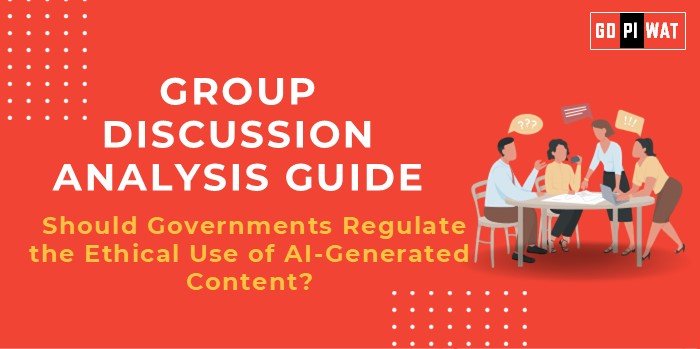📋 Group Discussion (GD) Analysis Guide: Should Governments Regulate the Ethical Use of AI-Generated Content?
🌐 Introduction to the Topic
- 🔍 Opening Context: As AI technologies rapidly evolve, their impact on content creation—from deepfakes to AI-generated art and writing—has triggered global debates on ethics, intellectual property, and misinformation. This topic resonates profoundly for B-school aspirants as it combines elements of ethics, technology, and policy.
- 📖 Topic Background: AI-generated content, driven by models like ChatGPT and DALL-E, represents a transformative trend. Governments and global organizations face challenges in balancing innovation with ethical use, public trust, and misinformation control. The European Union’s AI Act and UNESCO’s AI Ethics framework exemplify growing regulatory focus.
📊 Quick Facts and Key Statistics
– 🌐 Deepfake Market Value: Projected to reach $3.9 billion by 2030, emphasizing its rapid proliferation.
– 💡 AI-Generated Content Volume: Over 1.5 billion AI-generated images and texts produced monthly (2024).
– ⚠️ Misinformation Risks: 68% of adults globally express concern about deepfakes undermining trust in media (Pew Research, 2023).
– 💶 EU AI Regulation Budget: €1 billion for research and compliance (2024).
– 💡 AI-Generated Content Volume: Over 1.5 billion AI-generated images and texts produced monthly (2024).
– ⚠️ Misinformation Risks: 68% of adults globally express concern about deepfakes undermining trust in media (Pew Research, 2023).
– 💶 EU AI Regulation Budget: €1 billion for research and compliance (2024).
🤝 Stakeholders and Their Roles
- ⚖️ Governments: Create frameworks for ethical AI use and address misuse.
- 💻 Tech Companies: Innovate responsibly while aligning with ethical standards.
- 👥 Citizens: Promote digital literacy and responsible content consumption.
- 📚 Media & Academia: Research and educate about ethical challenges and solutions.
🏆 Achievements and Challenges
✨ Achievements:
- 🎨 AI for Creativity: Democratized access to tools for art, writing, and music production.
- 🔍 Content Moderation: AI models assist in detecting hate speech and misinformation.
- 🌍 Global Cooperation: UNESCO’s ethical AI guidelines have gained international traction.
⚠️ Challenges:
- 🛑 Misinformation Proliferation: Deepfakes erode trust in digital content.
- 📜 Intellectual Property Issues: Artists and writers grapple with AI plagiarizing human creativity.
- ⚖️ Uneven Regulation: Different countries lack uniform AI content laws, complicating global enforcement.
🌍 Global Comparisons:
– EU AI Act: Sets clear compliance standards for generative AI models.
– China’s Regulation: Stricter rules requiring watermarks on AI-generated content.
📌 Case Study: 2023 US Elections: Misleading AI-generated political ads demonstrated ethical and regulatory gaps.
🧠 Structured Arguments for Discussion
- ✅ Supporting Stance: “Government regulations are essential to curb misuse of AI-generated content and safeguard public trust.”
- ❌ Opposing Stance: “Regulation may stifle innovation and hinder the creative potential of AI-driven industries.”
- ⚖️ Balanced Perspective: “While regulation is necessary to mitigate risks, a flexible approach is essential to foster innovation.”
🎯 Effective Discussion Approaches
- 📜 Opening Techniques:
- 📈 Start with a statistic: “AI-generated content will form 90% of online data by 2030.”
- 📌 Cite case studies: Use examples like the misuse of deepfakes in media.
- 🔍 Counter-Argument Handling:
- Acknowledge creative freedom concerns but highlight real-world harm from unregulated use.
🔍 Strategic Analysis of Strengths and Weaknesses
- 💪 Strengths: Innovation potential in art, marketing, and education; assistive technologies for accessibility.
- ⚠️ Weaknesses: High susceptibility to abuse for misinformation; biases inherent in AI algorithms.
- 🚀 Opportunities: Creating global standards for ethical AI use; collaboration between public and private sectors.
- ⚡ Threats: Loss of trust in digital media; accelerated spread of false narratives.
🎓 Connecting with B-School Applications
- 🌟 Real-World Applications: Ethical AI aligns with business strategies, operations, and marketing innovations.
- ❓ Sample Interview Questions:
- “Should corporations self-regulate AI content to avoid government intervention?”
- “What role does ethics play in the scalability of AI technologies?”
- 💡 Insights for B-School Students:
- Use AI ethics as a lens for analyzing corporate social responsibility (CSR).
- Explore AI’s impact on branding and consumer trust in projects or internships.


